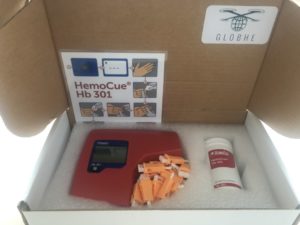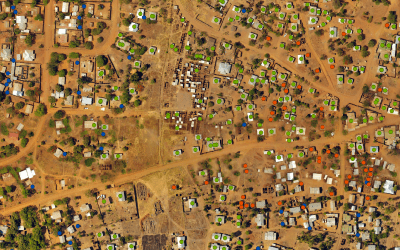One of the best things about life on the road is the opportunity to meet new companies and new people stretching the boundaries of what drones can do for communities around the world. At the recent Commercial UAV Show in London, DRONELIFE had the opportunity to meet Helena Samsioe, CEO and Founder of Swedish based drone service provider GLOBHE. GLOBHE’s mission is to use drone technologies for delivery of perishable medical supplies and allow for disaster relief planning by the use of early, on the scene, drone photography.
There are two elements to the work that GLOBEHE provides: delivery of medical supplies in hard to reach areas, and capturing images that automatically trigger data used to determine key information such as road quality, flooding and the number of households in an affected area after a natural disaster. Both of these missions demonstrate the unique value that drones can provide. “Drones for good” is the philosohpy behind GLOBHE, it’s an idea that resonates. Helena and she and her company have been featured in the Forbes woman in Europe 50, and written up by the BBC. Her company has partnered with UNICEF and other international disaster relief service organizations to provide delivery or medical supplies as well as to access local conditions via a drone to allow the most effect relief planning.
Helena’s background and focus came from personal experience. Helena’s parents worked as doctors globally, and she had the chance to see first hand the challenges and opportunities that drone technologies can provide in Africa and Asia.
DroneLife: You have been doing this for a while now, both the delivery of medical supplies and doing disaster relief imagery. Where have you seen the biggest benefit for drone usage in these types of applications and why?
Helena: “So far the biggest benefit we have seen is the capability of drones to quickly collect image data that serves as valuable insights in disaster relief and other related areas. When we connect the drone image data to artificial intelligence (automatic object detection) it really transforms the ease and speed of analysis of the data for our end clients, enabling them to take more informed decisions faster.
The ability of drones to reduce transportation time of medical cargo delivery is also significant, but in many places regulatory frameworks and lack of supportive infrastructure still hinder drone delivery at scale, hence the drone mapping industry is more mature. “
DroneLife: How was this done before the use of drones?
Helena: “In many cases there was a huge information gap because the data was simply not obtainable in a feasible way. Traditional airplanes were sometimes used but very costly. Satellite data has been used also and is still being used a lot, but satellite data lags in time and isn’t of as good quality and therefore become quite useless for some scenarios.
As for transportation of medical cargo this is usually done my cars or motorcycles, which makes deliveries slow to hard to reach areas and during flooding season some areas can’t be reached at all via ground transportation. Traditional airplanes are often too expensive to bring in and don’t make much sense for frequent small volume deliveries.”
DroneLife: As we are now close to 2019, what do you anticipate as the next steps in the usage of drones in medical supplies and disaster relief planning?
Helena: I think we are at a time where two big tech challenges need to be addressed that we already have started to see some solutions to: namely the limited battery life and the limited payload capacity of smaller drones. Besides that, I had hoped for regulatory frameworks to have been more developed by now – but it takes time, perhaps 2019 is the year. I also think we are finally starting to leave the small pilot projects behind and move into more full scale sustainable operations, which is a result of drone knowledge and the value the technology can bring has become more wide spread. Last but not least we are already seeing and will be seeing even more merging of technologies such as drones and AI.
DroneLife: What has been your biggest frustration and why?
Helena: That everything takes more time than you had hoped for- but patience is key here.
DroneLife: What did I not ask you about that you would like our readers to know about?
Helena: Something interesting for your readers to know is that GLOBHE very often works in partnerships, and outsource a lot of our flying missions to local drone pilots around the world. And as for our Drone Services, we provide a package for our clients that is made up by components from different tech manufacturers – perhaps a company out there has a solution that could be integrated. So for anyone reading this interested in partnering up: reach out and we’ll talk!
In addition to services, GLOBEHE is working to productize the delivery of medical supplies and data insights and analysis.
GLOBEHE in partnership with diagnostics kit provider, HemoCue, are improving access to diagnostic services by delivering point of care testing devices by drones to hard to reach areas. The idea is that the product DRONEED provides a “delivery in a box” with regulatory information, customized roll-out plans, drones and flight Control System, cargo boxes with temperature monitoring, a UTM System, and test flights and training.

On the planning side, GLOBHE’s has created a subscription-based service named identifAI, which is a product and service that allows for custom object detection software via AI.
That also gives customers access to a global network of drone pilots, drone data collection, drone data analysis using AI and GIS, and drone data visualization to identify key insights.

CEO DroneLife.com, DroneRacingLife.com, and CMO of Jobfordrones.com. Principle at Spalding Barker Strategies. Proud father of two. Enjoys karate, Sherlock Holmes, and interesting things. Subscribe to all things drone at DroneLife here.
https://dronelife.com/2018/11/28/swedish-company-globhe-is-focused-on-drones-doing-good-in-hard-hit-relief-areas/
 Unmanned Aerial Vehicle The latest drone news
Unmanned Aerial Vehicle The latest drone news






